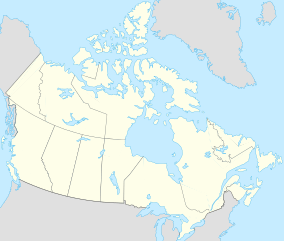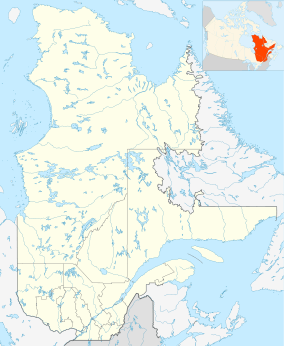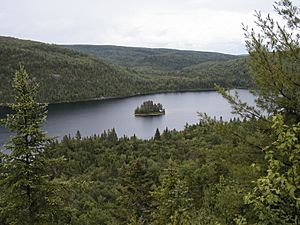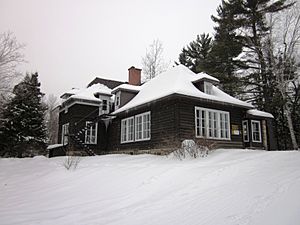La Mauricie National Park facts for kids
Quick facts for kids La Mauricie National Park |
|
|---|---|
|
IUCN Category II (National Park)
|
|

Wapizagonke Lake viewed from the lookout "Le passage"
|
|
| Location | Saint-Mathieu-du-Parc, Quebec, Canada |
| Area | 536 km2 (207 sq mi) |
| Established | 22 August 1970 |
| Visitors | 149,521 (in 2007) |
| Governing body | Parks Canada |
La Mauricie National Park (in French: French: Parc national de la Mauricie) is a beautiful national park in Quebec, Canada. It's found near the city of Shawinigan, in the Laurentian Mountains. The park is huge, covering about 536 square kilometers (207 square miles)!
This amazing park is part of the southern Canadian Shield, a very old rocky area. It's also close to the Saint Lawrence River. Inside the park, you'll find more than 150 lakes and many smaller ponds.
The park's forests are a mix of conifer (like pine and spruce) and deciduous trees (like maple and birch). These forests were once used for logging, but they have grown back strong and healthy.
La Mauricie National Park is home to many animals, including moose, black bears, beavers, and otters. You might even spot a rare wood turtle! It's a great place for fun outdoor activities like camping, canoeing, and kayaking.
The park gets its name from the nearby Saint-Maurice River, which flows to its east. The Matawin River forms the park's western and northern edges.
Contents
What's in a Name?
The name "Mauricie" was first used in 1933. It describes a special area in Quebec, with the Saint-Maurice River as its most important feature.
The Saint-Maurice River itself is named after Maurice Poulin La Fontaine. He was a lord who was given land near the river's mouth in 1676. Before this, the river was sometimes called "River Three Rivers."
Different Indigenous peoples have their own names for the river. The Atikamekw call it Tapiskwan Sipi, which means "River of the threaded needle." The Wyandot people know it as Oquintondili, and the Abenaki call it Madôbalodenitekw.
Where is the Park?
La Mauricie National Park is located in Quebec, Canada. It's about 15 kilometers (9 miles) north of Shawinigan and 45 kilometers (28 miles) north of Trois-Rivières.
You can get to the park from the villages of Saint-Jean-des-Piles and Saint-Mathieu-du-Parc. The park is next to the Saint-Maurice River on its east side and the Matawin River to the north.
Park's Landscape
The park is part of the Canadian Shield, a very old and strong rock formation. The land gently slopes from east to west, with heights ranging from 150 meters (490 feet) to nearly 500 meters (1,640 feet). This area has ancient rocks that are about 955 million years old!
Long ago, huge glaciers covered this land. When they melted, they left behind many valleys and faults, shaping the landscape we see today.
Lakes and Rivers
The park is famous for its many lakes, about 150 of them! Some are small, acidic bogs high up, while others are large, clear lakes in the valleys.
All the lakes and streams in the park eventually flow into the big Saint-Maurice River. This happens through smaller rivers like the "À la pêche" River, the Matawin River, and the Shawinigan River.
Plants and Animals
La Mauricie National Park is a special place for nature. It's part of a large area of mixed forests in the southern part of the Canadian Shield.
Park Plants
The park is home to over 440 types of plants, including many different kinds of trees, lichens, and mosses. There are even 27 rare plant species here!
Forests cover most of the park, about 93% of the land. You'll find about 30 different kinds of trees. Common trees include maple and yellow birch, which grow on sunny, well-drained slopes. Balsam fir, pine, and spruce trees grow on rocky cliffs and in wet areas. One tree, the butternut, is an endangered species found in the park.
Park Wildlife
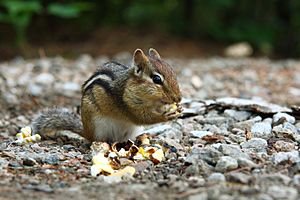
The park is full of amazing animals! You might see a Chipmunk scurrying around. Many birds live here, like the ruffed grouse, blue jay, and black-capped chickadee. Birds of prey, like the broad-winged hawk and great horned owl, also fly overhead.
The common loon, a beautiful water bird, is a symbol of the park. It nests in the park's aquatic areas. There are eight species of birds that are considered at risk in the park, including the whip-poor-will and the peregrine falcon.
The park has five types of reptiles, including the wood turtle (which is endangered) and the painted turtle. You can also find 14 types of amphibians, like salamanders and frogs.
Many mammals call the park home, such as snowshoe hares, raccoons, moose, beavers, porcupines, river otters, black bears, and even wolves.
Most of the lakes have a small number of fish. The brook trout is common, especially in the northern parts of the park. Some lakes also have a unique population of char. Over the years, humans have introduced 19 different types of fish into the lakes.
Park History
People have lived in or visited the area of La Mauricie National Park for a very long time. The oldest signs of humans date back between 7,000 and 3,000 BC! Early Native Americans lived in small family groups, fishing, hunting, and gathering food.
There are even ancient cave paintings on a cliff at Lake Wapizagonke. These paintings give us a glimpse into the spiritual beliefs of Native Americans from that time.
From the 17th century, the Atikamekw and Algonquian peoples used the area for trapping and hunting. Later, in the mid-19th century, the Abenaki also used the park area for hunting and trading.
Logging and Clubs
In the early 1800s, logging began in the park area. People cut down large white and red pines for lumber. This continued until about 1925, when these big trees became scarce. Then, the focus shifted to cutting wood for paper. The Mauricie region became a major paper producer in the early 20th century.
Logging changed the forests a lot. People planted new trees like white spruce, and there were big forest fires in 1910 and 1954.
In the late 1800s, wealthy American tourists started coming to the area. They opened private hunting and fishing clubs. These clubs, like the Shawinigan Club (1883) and the Laurentian Club (1886), allowed members to hunt and fish in the territory. While they helped protect some nature, they also introduced many non-native fish species into the lakes.
Today, only the "Wabenaki and Andrew lodges" remain from these old clubs. They were part of the Laurentian Club. Parks Canada bought them in 1972 and turned them into places for visitors to stay.
La Mauricie National Park was officially created on August 21, 1970. This stopped the activities of the 16 private clubs that were operating in the area, making it a protected space for everyone to enjoy.
Fun Activities
La Mauricie National Park offers many exciting activities for visitors!
Canoe Camping
One popular activity is canoe camping. The park has a special circuit that lets you paddle across a dozen lakes deep in the wilderness. You'll connect these lakes by carrying your canoe over short paths called portages. There are about 200 camping sites that you can only reach by boat!
Other Adventures

- Swimming in the clear lakes
- Camping at various sites
- Canoeing and Kayaking on the many waterways
- Hiking on beautiful trails
- Rabaska (a large canoe) paddling
- Snowshoeing in winter
- Skiing in winter
See also
 In Spanish: Parque nacional La Mauricie para niños
In Spanish: Parque nacional La Mauricie para niños


